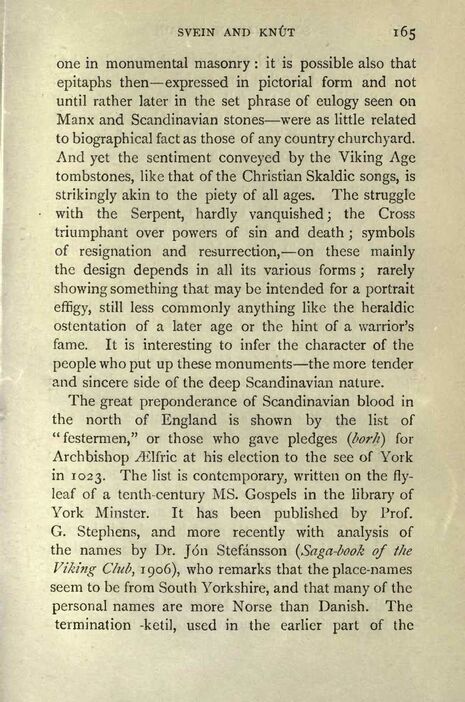
Full resolution (JPEG) - On this page / på denna sida - Scandinavian Britain - II. The Danelaw - 5. Svein and Knút

<< prev. page << föreg. sida << >> nästa sida >> next page >>
Below is the raw OCR text
from the above scanned image.
Do you see an error? Proofread the page now!
Här nedan syns maskintolkade texten från faksimilbilden ovan.
Ser du något fel? Korrekturläs sidan nu!
This page has been proofread at least once.
(diff)
(history)
Denna sida har korrekturlästs minst en gång.
(skillnad)
(historik)
one in monumental masonry : it is possible also that
epitaphs then—expressed in pictorial form and not
until rather later in the set phrase of eulogy seen on
Manx and Scandinavian stones—were as little related
to biographical fact as those of any country churchyard.
And yet the sentiment conveyed by the Viking Age
tombstones, like that of the Christian Skaldic songs, is
strikingly akin to the piety of all ages. The struggle
with the Serpent, hardly vanquished; the Cross
triumphant over powers of sin and death ; symbols
of resignation and resurrection,—on these mainly
the design depends in all its various forms ; rarely
showing something that may be intended for a portrait
effigy, still less commonly anything like the heraldic
ostentation of a later age or the hint of a warrior’s
fame. It is interesting to infer the character of the
people who put up these monuments—the more tender
and sincere side of the deep Scandinavian nature.
The great preponderance of Scandinavian blood in
the north of England is shown by the list of
"festermen," or those who gave pledges (borh) for
Archbishop Ælfric at his election to the see of York
in 1023. The list is contemporary, written on the flyleaf
of a tenth-century MS. Gospels in the library of
York Minster. It has been published by Prof.
G. Stephens, and more recently with analysis of
the names by Dr. Jón Stefánsson (Saga-book of the
Viking Club, 1906), who remarks that the place-names
seem to be from South Yorkshire, and that many of the
personal names are more Norse than Danish. The
termination -ketil, used in the earlier part of the
<< prev. page << föreg. sida << >> nästa sida >> next page >>